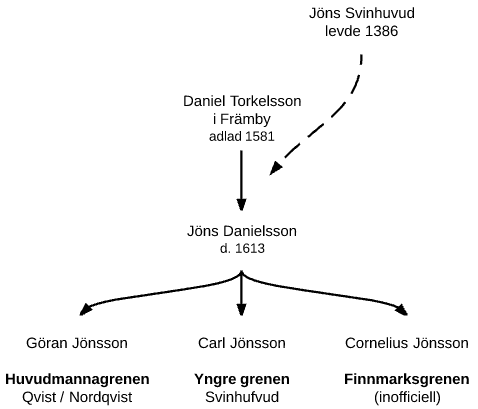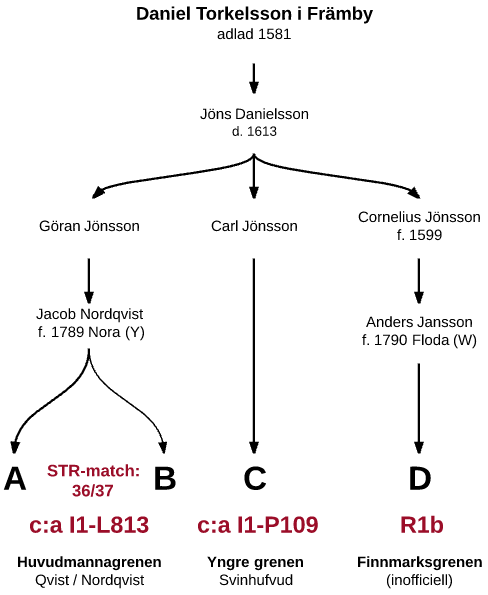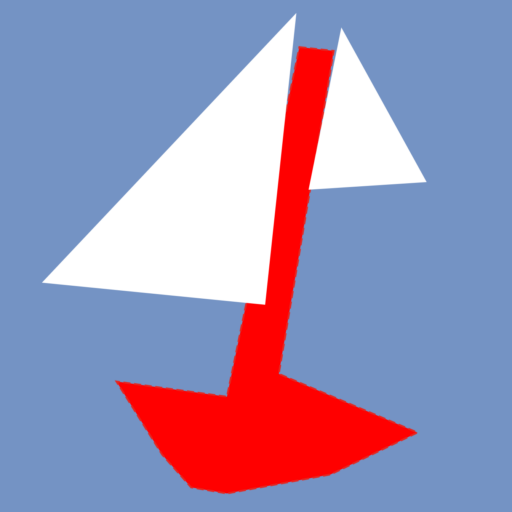Background
Jöns Svinhuvud (or "Swinshwow" as he is referred to) is an almost mythical person known from the so-called Svinhuvud letter, the contract in which he buys the mining farms Höjen and Stämnarvet from the Vestmod sons in 1386 (1). His descendants can be counted in the tens of thousands because the family lines are widely spread in the area around Stora Kopparberget and surroundings in southern Dalarna. When someone is a descendant of Svinhuvud, it usually means a kinship on more or less winding roads through both mothers and fathers back to Jöns.
A few of these descendants really bear the surname Svinhufvud. They are not named directly from Jöns Svinhuvud, but they belong to one of the families after one of two mountain men at Stora Kopparberget who were ennobled in the 16th century; Hans Persson and Daniel Torkelsson.
Daniel Torkelsson
Daniel Torkelsson in Främby was ennobled in 1581 Svinhufvud in Westergötland. As far as is known, he was not a Pig's Head descendant himself, but he got the idea for the coat of arms from his wife, whose grandfather's grandfather is said to have been the son of Jöns (2).

Daniel's son Jöns had three sons who have agnatic (father-son-grandson lines) descendants in the present day:
- Göran Jönsson Svinhufvud who gave rise to The principal branch (HRS)
The descendants left the name Svinhufvud early on and instead took the name Qvist, later Nordqvist. The branch was long forgotten but was rediscovered in the late 1970s by Thord Bylund. The investigation was approved by Riddarhuset. - Carl Jönsson Svinhufvud, died 1636, author of Younger branch (Y)
Today's agnatic descendants bear the name Svinhufvud. - Cornelius Jönsson whose descendants belong to the unofficial The Finnmark branch (F)
Cornelius lived in small circumstances at Flen in Floda parish's finnmark (3). Edelfeldt says that Cornelius is said to have participated in the war in Poland as a young man and then eventually became a poor crofter. He was recorded in the census records as "Finn".
DNA testing
For the basics of testing paternal lines (agnatic lines), Y-DNA, see, for example, my blog post "To secure my lineage from Höjen".
Four contemporary descendants of Daniel Torkelsson Svinhufvud in Westergötland have been tested. The test used is Y-DNA37 from FamilyTreeDNA. The Y-chromosome is inherited from father to son to son-son, which is why an analysis of Y-DNA gives an idea of the genetics of the agnatic kinship.
The test provides 37 STR markers that can be used to give a rough picture of kinship. If the markers of two testers agree well, it is reasonable to believe that they are closely related. The test also provides a haplogroup for the person. If necessary, one can then proceed with further analyzes to give a more accurate picture of the kinship.
They tested
- A and B Two men from the principal branch. They are foursome and have Jacob Nordqvist b. 1789 in Nora (Y) as their common ancestor.
- C A man with the surname Svinhufvud
- D A man who is an agnatic descendant of Cornelius Jönsson on Flen through Cornelius' great-great-great-grandson's son Anders Jansson, b. 1790.
Men A, B and C can be found in Adelskalendern 2016, chapter Svinhufvud in Westergötland. Man D has been traced based on Edfeldt's presentation of the Finnmark branch.
The result
The result from the DNA analysis (37 markers) looks like this:

It is quite obvious that the four results can be divided into three groups. Sample A and B belong together. They have almost the same markers, only a value of 37 markers differs (the first one, DYS393). It fits well with what was expected, that they have a common ancestor four generations back. The ancestor Jacob Nordqvist can thus be considered genetically confirmed.

A and B are estimated to belong to a haplogroup most similar to I1-L813 while D belongs to R1b and C seems to belong to I1-P109. All three are very different from each other. I1-P109 and I1-L813 separated about 4000 years ago, while R1b branched off from the common lineage of these two about 47000 years ago.
Conclusion
The three agnatic lines to the present from the son of Daniel Torkelsson Svinhufvud in Westergötland have been tested with four Y-DNA37 tests. If the traditional genealogy had agreed with the genetic kinship, then the agreement between the tests would have been great. However, it has been shown that all the three lines tested belong to very different haplogroups. This means that in at least a couple of places in the lines, unknown events have occurred that make genetics and traditional research not agree. With these tests, it is not possible to say anything about where on the lines the events occurred.
On the other hand, it is established with high certainty that the two Nordqvist quadruplets on the main line are genetically descended from Jacob Nordqvist who lived in the Noratrakten in the current Kramfors municipality around the year 1800.
Jakob Norstedt
E-mail: jakob@hoijen.se
References
- On the origin of the Svinhuvud family, Torsten Berglund, Elisabet Hemström, Leif Olofsson and Anders Winroth, Genealogists' yearbook 2008
- The common origin of the Svinhufvud families, Anders Winroth, Släkt og hævd 2001 2-3
- Cornelius Svinhufvud and his family 1 and 2, Walter Edelfeldt 1977-1982
- The nobility calendar 2016
- The FTDNA Project Copper Mountain
